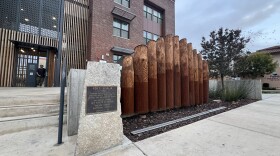On a hot Central Valley day a trip to the beach is one of the best ways to cool off. Today that usually involves getting in the car and heading to the coast. But a century ago in Fresno, it involved getting on a streetcar. Today on KVPR’s Central Valley Roots, the story of Fresno Beach – and the Fresno Traction Company.
In the early 20th century Fresno had an extensive streetcar network. Starting in 1902 electric streetcars rolled around downtown Fresno and surrounding residential neighborhoods, as they did in larger cities. After 1903, they were operated by the Fresno Traction Company. In 1914, the tracks got extended north. Real estate developer J.C. Forkner partnered with the trolley company to extend the tracks through his new Fig Garden development, all the way to the San Joaquin River.

It was an 11 mile trip from downtown Fresno, as the tracks ran down Fulton Street to Wishon, before turning west on Shaw Avenue and then north on Forkner. From there they turned west again descending the bluffs to a horseshoe bend on the river near the former Fig Garden Golf Club.
There Forkner built the privately owned River View Park. It had a merry-go-round, dance hall and a sandy area along the river’s edge known as Fresno Beach. From 1914 through 1932 Fresno residents enjoyed their seasonal trips to the river. But the rise of the automobile and the Great Depression doomed the trolley.
Fresno Beach eventually became a camp for local Boy Scouts. In the year 2000, the Fresno County Office of Education purchased the 84 acres, now known as Scout Island, and home to an outdoor education center for local school districts.







